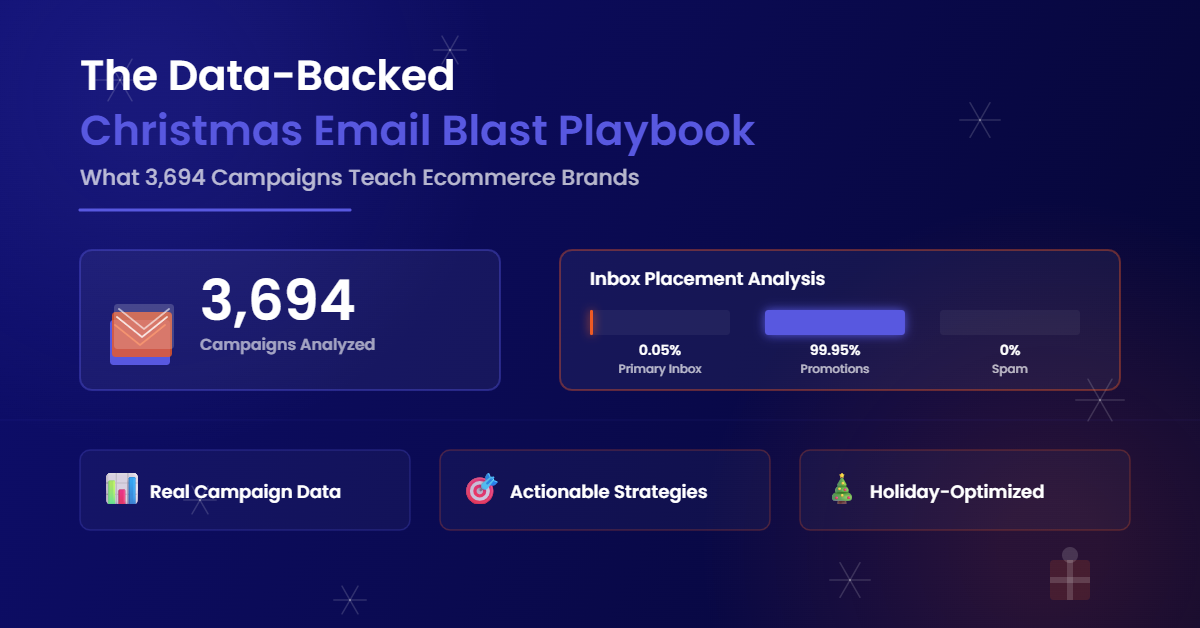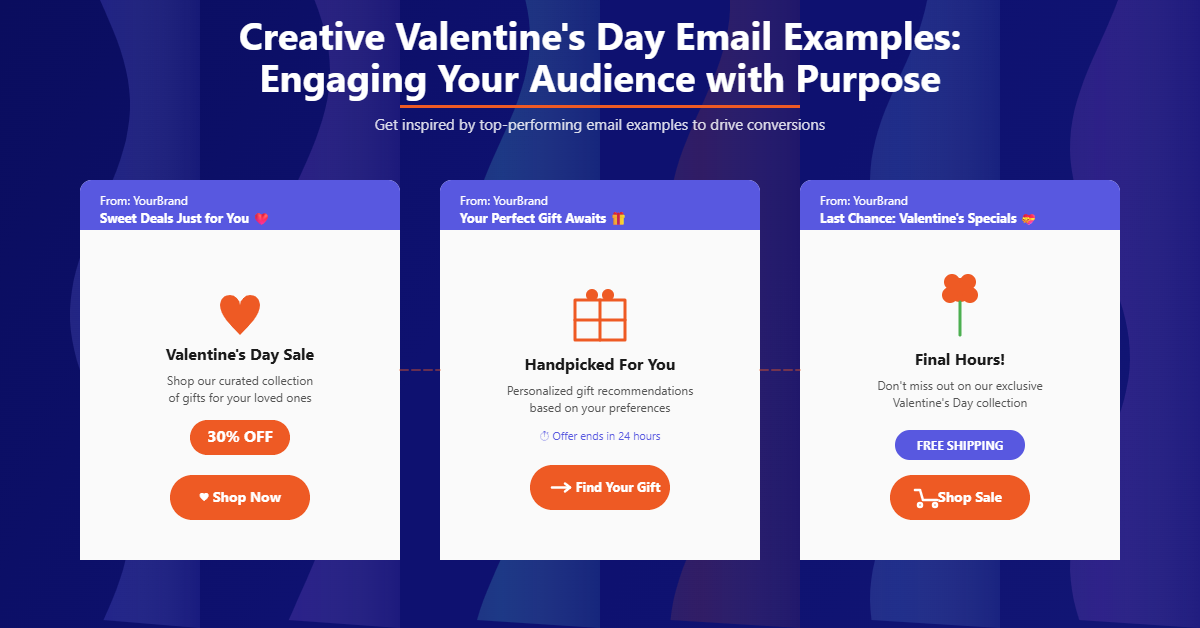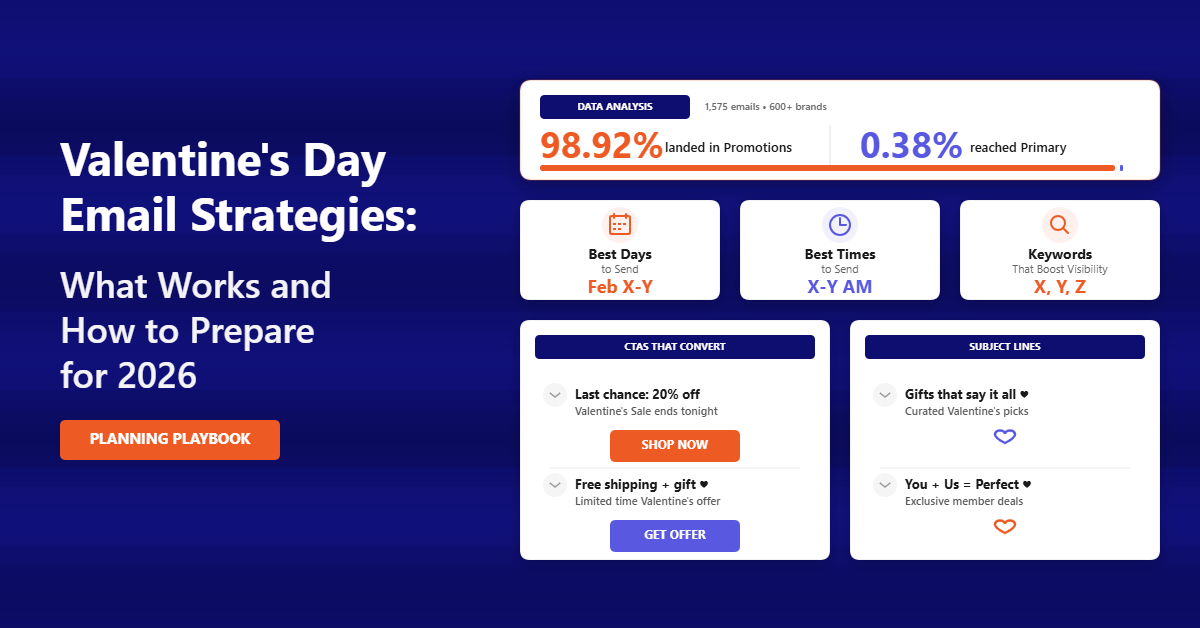Quick Summary
🎄 Promotions-tab dominance is universal: With 99.95% of Christmas email blasts landing in Promotions, success depends on relevance and design clarity, not bypassing filters.
📅 Optimal cadence aligns with behavior: Brands sending every 2–4 days, matching the dataset’s 3.04-day average, maintain visibility without causing fatigue or hurting engagement.
📬 Frequency doesn’t trigger Spam: Zero correlation between send frequency and Spam placement shows human attention is the real limiter of holiday performance.
📈 Midweek leads, weekends offer hidden gains: While Wednesday saw 673 sends, weekend sends deliver contrarian visibility for mobile-first shoppers when content relevance stays sharp.
⚡ Low-friction messaging wins: Data shows campaigns with simple urgency, low punctuation, and precise CTAs earn more clicks by reducing friction and matching real shopper intent.
The busiest week of the year for your customers’ inboxes is not a myth. It’s measurable.
In our review of 3,694 campaigns from 1,124 brands, nearly every Christmas email blast landed in the Promotions tab, with an almost nonexistent share reaching the primary inbox.
Yet despite the noise, brands that respected cadence, timing, and copy discipline still earned attention and clicks.
What 3,694 Christmas Email Blasts Reveal About the Season
We analyzed 3,694 email campaigns sent by 1,124 e-commerce brands during the peak holiday.
The folder placement results were stark: only 0.05% hit the primary inbox, 99.95% went to Promotions, and 0% to Spam. That tells a clear story; your Christmas email blast will compete on relevance and design cues in Promotions, not on bypassing filters.
That Promotions reality isn’t a problem to beat; it’s a context to master. Customers expect to see holiday offers in Promotions.
The brands that win treat it like a competitive shelf in a store: make your offer obvious, your timing considerate, and your messaging unmistakable.
Frequency benchmarks: how often brands actually send
Across the 1,124 brands, send frequency is clustered into four brackets. About 42.52% of brands sent one campaign, 33.27% sent two to three, 13.96% sent four to six, and 10.23% sent seven or more.
The average gap between sends was 3.04 days, which reflects the high-intent nature of the season without descending into fatigue.
The cadence data suggests a practical ceiling for most retailers. A Christmas email blast every two to four days aligns with the average, keeps inventory and shipping updates timely, and creates enough space for segmentation and creative refreshes.
The minority of brands sending seven or more blasts are often category leaders or promotional-heavy retailers with broader segmentation that can support higher frequency.
Does sending more risk Spam? Not in this dataset
The cleanest deliverability insight in our analysis is also the most surprising.
There was no correlation between frequency and Spam placement. In fact, Spam placement registered at 0% across the dataset.
That doesn’t mean you can send indiscriminately. It means more than filters; human attention is your main constraint.
Over-sending can still depress engagement, which, over time, can hurt reputation and inboxing. The smarter play is to keep frequency steady, tighten audience relevance, and let your Christmas email blast stand out on clarity rather than volume.
More Christmas Email Marketing Resources for You
Timing your Christmas email blast for maximum visibility
The most common send days clustered heavily in the Monday–Friday window, with a midweek surge.
Wednesday topped the week with 673 blasts, followed by Tuesday at 598, Thursday at 583, Monday at 577, and Friday at 556. Saturday and Sunday saw much lower volume.
There are two ways to read this pattern. Midweek sends put you in the stream where shoppers naturally expect offers, but they also heighten competition.
Weekend sends can feel contrarian and may attract incremental attention, especially for mobile-first audiences, but they require sharper relevance to earn the tap.
A balanced approach works well. Keep core offer communications in the midweek window to match buyer behavior, then reserve weekend slots for cart movers and loyalists.
When you combine timing with the three-day cadence average, you get a rhythm that feels dependable rather than pushy.
Subject lines that sell without tripping soft filters
Holiday urgency is real, and brands lean on it. Among the campaigns analyzed, 14.87% included caps lock in the subject line, urgency keywords appeared in 14.83% of subjects, and the average punctuation count was just 0.53 per subject.
The patterns show that marketers try to shout, but the better ones do it sparingly.
All caps can grab a glance, but frequent shouting blends into the noise. Using urgency terms like “final,” “last,” or “hurry” works best when tied to an actual deadline such as shipping cutoffs or a limited drop.
The low average punctuation count is a helpful cue, half a punctuation per subject suggests short, clean lines outperform clutter.
Consider subject lines that promise a benefit and deliver a reason to act now. For example, “Guaranteed delivery by Friday—25% off ends tonight” sets a timeline and an incentive without gimmicks.
Pair it with a pre-header that adds a second hook, such as “Free returns through January 15.”
What high-frequency senders do with CTAs
In the 115 brands that sent seven or more blasts, CTA language skewed toward direct action.
“Shop now” appeared 142 times, while deal and category directives like “Deals,” “Clearance,” “Shop Men,” and “Shop Women” each landed in the 42–29 range.
Seasonal prompts like “Shop for the Holidays,” along with softer CTAs such as “Learn more” and “Shop,” clustered in the 16–23 range.
The takeaway is simple. When customers are in buying mode, the most successful CTAs reduce friction and frame intent.
“Shop now” works because it’s familiar and fast, but repeating it in every message can dull response. Rotating with category-specific CTAs helps guide shoppers to the right aisles without extra clicks.
Let your CTA follow the content. Big sitewide events can carry a single “Shop now,” but targeted sends benefit from more precise CTAs like “Gift her favorites,” “Upgrade his basics,” or “Claim your reward.”
Small shifts in CTA language can move late-season revenue, especially when you align them with segmentation and product availability.
The folder placement reality check every marketer needs
Across 3,694 campaigns, 99.95% landed in Promotions and only 0.05% reached the primary inbox.
That reality changes how you design a Christmas email blast. The Promotions tab is a merchandising experience. Your brand competes not just on open rate, but on the clarity of your subject line, the promise of your preheader, and the instant recognizability of your sender name.
Instead of chasing the primary inbox, make Promotions work harder. Establish a recognizable sender name customers associate with value. Keep subject lines compact and grounded in specifics.
Use pre-headers to deliver the second-most important benefit so that, even at a glance, your message looks like a complete offer.
Consider cross-channel assists to lift attention at critical moments. A well-timed SMS to VIPs about the final shipping cutoff, paired with a same-day Christmas email blast, can nudge decisive action without over-sending to your entire file.
Platforms like TargetBay Email & SMS make that orchestration easier while keeping audience fatigue in check.
More Christmas Email Marketing Resources for You
A practical cadence and content playbook for the season
Start early with value-forward messaging that warms up your audience. A campaign every three to four days in early December builds anticipation without exhausting attention.
Use this window for gift guides, bundles, and first-access incentives that reward subscribers for staying engaged.
During peak, match the two-to-three-day rhythm common in the dataset. Keep messages anchored to real milestones like “ends tonight,” “price drop,” and “delivery by Friday.”
When you narrow the audience based on behavior: browsers, cart abandoners, and loyalty members, you can increase frequency without diluting impact. Your high-intent segments will tolerate and reward a faster drumbeat.
As shipping cutoffs approach, urgency becomes more credible. Pivot to pickup options if you have them, lean on digital gift cards, and remind customers of returns and exchanges to reduce buying friction.
Maintain copy discipline in subject lines and evolve your CTAs from “Shop now” to specific actions that suit last-minute needs, such as “Get it in time” or “Send a gift card.”
Make testing a habit
Even with strong benchmarks, your audience has its own rhythm. Treat each Christmas email blast as a testable asset.
Alternate midweek sends with a weekend slot for a key segment and track lift in click-to-open and revenue per send. Adjust frequency based on engagement thresholds that protect your sender reputation.
Test subject line frameworks rather than individual words. Compare value-first (“Extra 20% off gifts under $50”) with deadline-first (“Last day for 2-day delivery—ends midnight”) and track performance by segment.
Keep punctuation clean, avoid repeated caps, and align urgency with actual constraints to maintain trust.
Measure what matters inside Promotions. Opens matter, but clicks, click-to-open rate, and revenue per 1,000 recipients tell the real performance story.
Use those metrics to guide creative iteration, CTA choices, and audience refinements through the season.
Bringing it all together
The data shows that Christmas deliverability isn’t your biggest hurdle; sameness is. With 99.95% of campaigns landing in Promotions and zero evidence that higher send frequency triggers Spam, the winners will be the brands that respect cadence, choose their moments, and communicate with precision.
A steady rhythm every three days, midweek anchoring with selective weekend plays, disciplined subject lines, and clear CTAs will compound results.
Unified tools keep that strategy practical during peak. Coordinating your Christmas email blast with SMS reminders and on-site experiences through a platform like TargetBay Email & SMS helps you stay consistent without overwhelming your team.
When you layer in TargetBay Reviews to showcase social proof and TargetBay Rewards to motivate repeat purchases, you turn holiday shoppers into long-term customers.






